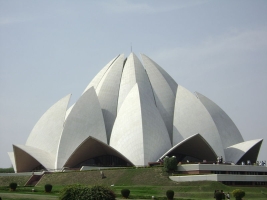Lotus Temple

The Lotus Temple, located in New Delhi, India, is a Bahá'í House of Worship
completed in 1986. Notable for its flowerlike shape, it serves as the Mother
Temple of the Indian subcontinent and has become a prominent attraction in
the city. The Lotus Temple has won numerous architectural awards and been
featured in hundreds of newspaper and magazine articles.
Worship
Like all other Bahá'í Houses of Worship, the Lotus Temple is open to all
regardless of religion, or any other distinction, as emphasized in Bahá'í
texts.
The Bahá'í laws emphasize that the spirit of the House of Worship be that it
is a gathering place where people of all religions may worship God without
denominational restrictions. The Bahá'í laws also stipulate that only the
holy scriptures of the Bahá'í Faith and other religions can be read or
chanted inside in any language; while readings and prayers can be set to
music by choirs, no musical instruments can be played inside. Furthermore no
sermons can be delivered, and there can be no ritualistic ceremonies
practiced.
Structure
All Bahá'í Houses of Worship, including the Lotus Temple, share certain
architectural elements, some of which are specified by Bahá'í scripture. `Abdu'l-Bahá,
the son of the founder of the religion, stipulated that an essential
architectural character of a House of Worship is a nine-sided circular
shape. While all current Bahá'í Houses of Worship have a dome, this is not
regarded as an essential part of their architecture. Bahá'í scripture also
states that no pictures, statues or images be displayed within the House of
Worship and no pulpits or altars be incorporated as an architectural feature
(readers may stand behind simple portable lecture stands).
Inspired by the lotus flower, the design for the House of Worship in New
Delhi is composed of 27 free-standing marble clad "petals" arranged in
clusters of three to form nine sides. The nine doors of the Lotus Temple
open onto a central hall slightly more than 40 meters tall that is capable
of holding up to 2,500 people.
The surface of the House of Worship is made of white marble from Penteli
mountain in Greece, the very same from which many ancient monuments and
other Baha'í Houses of Worship are built. Along with its nine surrounding
ponds and the gardens, the Lotus Temple property comprises 26 acres (105,000
m²; 10.5 ha).
The site is in the village of Bahapur, in the National Capital Territory of
Delhi. The architect was an Iranian, who now lives in Canada, named Fariborz
Sahba. He was approached in 1976 to design it and later oversaw its
construction. The structural design was undertaken by the UK firm Flint and
Neill. The major part of the funds needed to buy this land was donated by
Ardishír Rustampúr of Hyderabad, Sindh, who gave his entire life savings for
this purpose in 1953. A portion of construction budget was saved and used to
build a greenhouse to study indigenous plants and flowers that would be
appropriate for use on the site.
Tourism
Since its inauguration to public worship in December 1986, the Baha'í House
of Worship in Delhi has, as of late 2002, attracted more than 50 million
visitors, making it one of the most visited buildings in the world.
Its numbers of visitors during those years surpassed those of the Eiffel
Tower and the Taj Mahal. On Hindu celebrative days and holy days, it has
drawn as many as 150,000 people.
This House of Worship is generally referred to as the "Lotus Temple". In
India, during the Hindu festival Durga Puja, several times a replica of the
Lotus Temple has been made as a pandal, a temporary structure set up to
venerate the goddess Durga. In Sikkim a permanent replica is of the Hindu
Legship Mandir, dedicated to Shiva.
Distinctions
The Temple has received wide range of attention in professional
architectural, fine art, religious, governmental, and other venues.
Awards
1987, the architect of the Baha'í House of Worship, Mr. Fariborz Sahba, was
presented the award for excellence in religious art and architecture by the
UK-based Institution of Structural Engineers for producing a building "so
emulating the beauty of a flower and so striking in its visual impact".
1987, the Interfaith Forum on Religion, Art and Architecture, Affiliate of
the American Institute of Architects, Washington, D.C., gave their First
Honour award for "Excellence in Religious Art and Architecture" 1987 to Mr.
F. Sahba for the design of the Baha'í House of Worship near New Delhi.
1988, the Illuminating Engineering Society of North America conferred the
Paul Waterbury Outdoor Lighting Design Award - Special Citation for Exterior
Lighting.
1989, the Temple received an award from the Maharashtra-India Chapter of the
American Concrete Institute for "excellence in a concrete structure".
1994 edition of Encyclopaedia Britannica, in its 'Architecture' section
gives recognition to the Temple as an outstanding achievement of the time.
2000, Architectural Society of China as one of 100 canonical works of the
20th century in the recently published "World Architecture 1900-2000: A
Critical Mosaic, Volume Eight, South Asia".
2000, GlobArt Academy, based in Vienna, Austria, presented its "GlobArt
Academy 2000" award to the architect of the Lotus Temple, Fariborz Sahba,
for "the magnitude of the service of Taj Mahal of the 20th century in
promoting the unity and harmony of people of all nations, religions and
social strata, to an extent unsurpassed by any other architectural monument
worldwide."
Getting There
The nearest airport is Indira
Gandhi International Airport (IATA: DEL, ICAO: VIDP), situated in Palam,
15 km (9.3 mi) south-west of the New Delhi railway station and 16 km (9.9
mi) from New Delhi city centre.
undo ...back